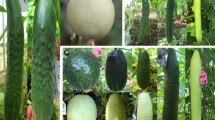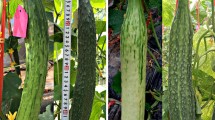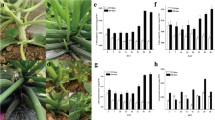Abstract
Key message
A single-nucleotide insertion resulted in a premature stop codon that is responsible for white immature fruit color in cucumber.
Abstract
Despite our previous progress in the mapping of the gene controlling white color in immature cucumber fruit and the identification of candidate genes, the specific gene that governs chlorophyll metabolism and its regulatory mechanism remains unknown. Here, we generated a mapping population consisting of 9497 F2 plants to delimit the controlling gene to an 8.2-kb physical interval that defines a sole candidate gene, APRR2. Sequencing the full-length DNA and cDNA of APRR2 allowed for identification of an allele, aprr2, encoding a truncated 101-amino acid protein due to a frameshift mutation and a premature stop codon. Gene structure prediction indicated that these 101 residues are located in a domain necessary for the function of the protein. The expression patterns of APRR2 were entirely consistent with the visual changes in green color intensity during fruit development. A microscopic observation of the fruit pericarp revealed fewer chloroplasts and a lower chloroplast chlorophyll storage capacity in Q24 (white) than in Q30 (green). A single-base insertion in the white color gene w, which leads to a premature stop codon, is hypothesized to have disabled the function of this gene in chlorophyll accumulation and chloroplast development. These findings contribute to basic research and the genetic improvement of fruit color.





Similar content being viewed by others
References
Adami M, De Franceschi P, Brandi F et al (2013) Identifying a carotenoid cleavage dioxygenase (ccd4) gene controlling yellow/white fruit flesh color of peach. Plant Mol Biol Reporter 31:1166–1175
Argyros RD, Mathews DE, Chiang Y-H et al (2008) Type B response regulators of arabidopsis play key roles in cytokinin signaling and plant development. Plant Cell 20:2102–2116
Azuma A, Kobayashi S, Yakushiji H et al (2007) VvmybA1 genotype determines grape skin color. Vitis 46:154–155
Barry CS, Aldridge GM, Herzog G et al (2012) Altered chloroplast development and delayed fruit ripening caused by mutations in a zinc metalloprotease at the lutescent2 locus of tomato. Plant Physiol 159:1086–1098
Beale S (1999) Enzymes of chlorophyll biosynthesis. Photosynth Res 60:43–73
Beale SI (2005) Green genes gleaned. Trends Plant Sci 10:309–312
Borevitz JO, Xia Y, Blount J et al (2000) Activation tagging identifies a conserved MYB regulator of phenylpropanoid biosynthesis. Plant Cell 12:2383–2393
Brand A, Borovsky Y, Meir S et al (2012) pc8.1, a major QTL for pigment content in pepper fruit, is associated with variation in plastid compartment size. Planta 235:579–588
Cheng C-Y, Kieber J (2014) Signaling: cytokinin signaling. In: Howell SH (ed) Molecular biology. Springer New York, pp 1–19
Clark MS (1997) Plant molecular biology—a laboratory manual. In: Clark DMS (ed). Springer, Berlin Heidelberg
Cortleven A, Schmülling T (2015) Regulation of chloroplast development and function by cytokinin. J Exp Bot 66:4999–5013
D’Agostino IB, Kieber JJ (1999) Phosphorelay signal transduction: the emerging family of plant response regulators. Trends Biochem Sci 24:452–456
Feller A, Machemer K, Braun EL et al (2011) Evolutionary and comparative analysis of MYB and bHLH plant transcription factors. Plant J 66:94–116
Fitter DW, Martin DJ, Copley MJ et al (2002) GLK gene pairs regulate chloroplast development in diverse plant species. Plant J 31:713–727
Forth D, Pyke KA (2006) The suffulta mutation in tomato reveals a novel method of plastid replication during fruit ripening. J Exp Bot 57:1971–1979
Han SE, Lee HE, Heo S et al (2011) Isolation and characterization of genes expressed differently in mature fruits of ‘redfield’ and ‘greensleeves’ apples. Hortic Environ Biote 52:413–421
Heyl A, Brault M, Frugier F et al (2013) Nomenclature for members of the two-component signaling pathway of plants. Plant Physiol 161:1063–1065
Hosoda K, Imamura A, Katoh E et al (2002) Molecular structure of the GARP family of plant Myb-related DNA binding motifs of the arabidopsis response regulators. Plant Cell 14:2015–2029
Huang S, Li R, Zhang Z et al (2009) The genome of the cucumber, Cucumis sativus L. Nat Genet 41:1275–1281
Hutchison CE, Li J, Argueso C et al (2006) The arabidopsis histidine phosphotransfer proteins are redundant positive regulators of cytokinin signaling. Plant Cell 18:3073–3087
Hwang I, Chen H-C, Sheen J (2002) Two-component signal transduction pathways in arabidopsis. Plant Physiol 129:500–515
Inskeep WP, Bloom PR (1985) Extinction coefficients of chlorophyll a and b in N, N-dimethylformamide and 80 % acetone. Plant Physiol 77:483–485
Kayesh E, Shangguan LF, Korir NK et al (2013) Fruit skin color and the role of anthocyanin. Acta Physiologiae Plantarum 35:2879–2890
Knerr LD, Staub JE, Holder DJ et al (1989) Genetic diversity in Cucumis sativus L. assessed by variation at 18 allozyme coding loci. Theor Appl Genet 78:119–128
Li Z, Huang S, Liu S et al (2009) Molecular isolation of the M gene suggests that a conserved-residue conversion induces the formation of bisexual flowers in cucumber plants. Genetics 182:1381–1385
Li YH, Yang LM, Pathak M et al (2011) Fine genetic mapping of cp: a recessive gene for compact (dwarf) plant architecture in cucumber, Cucumis sativus L. Theor Appl Genet 123:973–983
Li Z, Wang S, Tao Q et al (2012) A putative positive feedback regulation mechanism in CsACS2 expression suggests a modified model for sex determination in cucumber (Cucumis sativus L.). J Exp Bot 63:4475–4484
Li Y, Wen C, Weng Y (2013a) Fine mapping of the pleiotropic locus B for black spine and orange mature fruit color in cucumber identifies a 50 kb region containing a R2R3-MYB transcription factor. Theor Appl Genet 126:2187–2196
Li Z, Wang S, Gui X-L, et al. (2013b) A further analysis of the relationship between yellow ripe-fruit color and the capsanthin-capsorubin synthase gene in pepper (Capsicum sp.) Indicated a new mutant variant in C. annuum and a tandem repeat structure in promoter region. PLoS One 8
Li C, Li D, Shao F et al (2015) Molecular cloning and expression analysis of WRKY transcription factor genes in Salvia miltiorrhiza. BMC Genom 16:1–21
Liu H, Meng H, Pan Y, et al (2015) Fine genetic mapping of the white immature fruit color gene w to a 33.0-kb region in cucumber (Cucumis sativus L.). Theor Appl Genet 128:2375–2385
Livak KJ, Schmittgen TD (2001) Analysis of relative gene expression data using real-time quantitative PCR and the 2−ΔΔCT method. Methods 25:402–408
Lu S, Van Eck J, Zhou X et al (2006) The cauliflower Or gene encodes a DnaJ cysteine-rich domain-containing protein that mediates high levels of beta-carotene accumulation. Plant Cell 18:3594–3605
Ma N, Feng H, Meng X et al (2014) Overexpression of tomato SlNAC1 transcription factor alters fruit pigmentation and softening. BMC Plant Biol 14:351
Makino S, Kiba T, Imamura A et al (2000) Genes encoding pseudo-response regulators: insight into his-to-asp phosphorelay and circadian rhythm in Arabidopsis thaliana. Plant Cell Physiol 41:791–803
Motamayor JC, Mockaitis K, Schmutz J et al (2013) The genome sequence of the most widely cultivated cacao type and its use to identify candidate genes regulating pod color. Genome Biol 14:r53
Neff MM, Neff JD, Chory J et al (1998) dCAPS, a simple technique for the genetic analysis of single nucleotide polymorphisms: experimental applications in Arabidopsis thaliana genetics. Plant J 14:387–392
Pan Y, Bradley G, Pyke K et al (2013) Network inference analysis identifies an APRR2-Like gene linked to pigment accumulation in tomato and pepper fruits. Plant Physiol 161:1476–1485
Perochon A, Dieterle S, Pouzet C et al (2010) Interaction of a plant pseudo-response regulator with a calmodulin-like protein. Biochem Bioph Res Co 398:747–751
Popovsky S, Paran I (2000) Molecular genetics of the y locus in pepper: its relation to capsanthin-capsorubin synthase and to fruit color. Theor Appl Genet 101:86–89
Powell ALT, Nguyen CV, Hill T et al (2012) Uniform ripening encodes a Golden 2-like transcription factor regulating tomato fruit chloroplast development. Science 336:1711–1715
Pramnoi P, Somta P, Chankaew S et al (2013) A single recessive gene controls fragrance in cucumber (Cucumis sativus L.). J Genet 92:147–149
Pyke KA, Leech RM (1992) Chloroplast division and expansion is radically altered by nuclear mutations in Arabidopsis thaliana. Plant Physiol 99:1005–1008
Qi J, Liu X, Shen D et al (2013) A genomic variation map provides insights into the genetic basis of cucumber domestication and diversity. Nature Genet 45:1510–1515
Salamov AA, Solovyev VV (2000) Ab initio gene finding in Drosophila genomic DNA. Genome Res 10:516–522
Satbhai SB, Yamashino T, Okada R et al (2011) Pseudo-response regulator (PRR) homologues of the moss Physcomitrella patens: insights into the evolution of the PRR family in land plants. DNA Res 18:39–52
Shang Y, Ma Y, Zhou Y et al (2014) Biosynthesis, regulation, and domestication of bitterness in cucumber. Science 346:1084–1088
Singh R, Low E-TL, Ooi LC-L et al (2014) The oil palm VIRESCENS gene controls fruit colour and encodes a R2R3-MYB. Nature communications 5:4106
Tan J, Tao Q, Niu H, et al (2015) A novel allele of monoecious (m) locus is responsible for elongated fruit shape and perfect flowers in cucumber (Cucumis sativus L.). Theor Appl Genet 128:2483–2493
Wang L, Li J, Zhao J et al (2015) Evolutionary developmental genetics of fruit morphological variation within the Solanaceae. Front Plant Sci 6:248
Waters MT, Wang P, Korkaric M et al (2009) GLK transcription factors coordinate expression of the photosynthetic apparatus in Arabidopsis. Plant Cell 21:1109–1128
Weng Y (2014) Molecularly tagged genes and quantitative trait loci in cucumber. CUCURBITACEAE 2014, Bay Harbor, Michigan, USA, p 48
Weng Y, Johnson S, Staub JE et al (2010) An extended intervarietal microsatellite linkage map of cucumber, Cucumis sativus L. HortScience 45:882–886
Wheeler DL, Barrett T, Benson DA et al (2005) Database resources of the National Center for Biotechnology Information. Nucleic Acids Res 33:D39–D45
Xie J, Wehner TC (2001) Gene list 2001 for cucumber. Cucurbit Genet Coop. Report 24:110–136
Yang YN, Zhao G, Yue WQ et al (2013) Molecular cloning and gene expression differences of the anthocyanin biosynthesis-related genes in the red/green skin color mutant of pear (Pyrus communis L.). Tree Genet Genomes 9:1351–1360
Yang X, Li Y, Zhang W et al (2014a) Fine mapping of the uniform immature fruit color gene u in cucumber (Cucumis sativus L.). Euphytica 196:341–348
Yang X, Zhang W, He H et al (2014b) Tuberculate fruit gene Tu encodes a C2 H2 zinc finger protein that is required for the warty fruit phenotype in cucumber (Cucumis sativus L.). Plant J Cell Mol Biol 78:1034–1046
Yundaeng C, Somta P, Tangphatsornruang S, et al (2015) A single base substitution in BADH/AMADH is responsible for fragrance in cucumber (Cucumis sativus L.), and development of SNAP markers for the fragrance. Theor Appl Genet 128:1881–1892
Zhang SP, Miao H, Gu XF et al (2010) Genetic mapping of the scab resistance gene in cucumber. J Am Soc Hortic Sci 135:53–58
Zhou M-Y, Gomez-Sanchez CE (2000) Universal TA cloning. Curr Issues Mol Biol 2:1–7
Acknowledgments
We thank Dr. Husain Ahmad and Cuinan Wu for critical reading of the manuscript. We are grateful for the assistance provided by Yupeng Pan. This research was supported by a grant from the National Natural Science Foundation of China (Project #31372074).
Author information
Authors and Affiliations
Corresponding author
Ethics declarations
Conflict of interest
The authors declare that they have no conflict of interest.
Ethical standards
The authors declare that this study complies with the current laws of the countries in which the experiments were performed.
Additional information
Communicated by R. G. F. Visser.
Electronic supplementary material
Below is the link to the electronic supplementary material.
Rights and permissions
About this article
Cite this article
Liu, H., Jiao, J., Liang, X. et al. Map-based cloning, identification and characterization of the w gene controlling white immature fruit color in cucumber (Cucumis sativus L.). Theor Appl Genet 129, 1247–1256 (2016). https://doi.org/10.1007/s00122-016-2700-8
Received:
Accepted:
Published:
Issue Date:
DOI: https://doi.org/10.1007/s00122-016-2700-8




